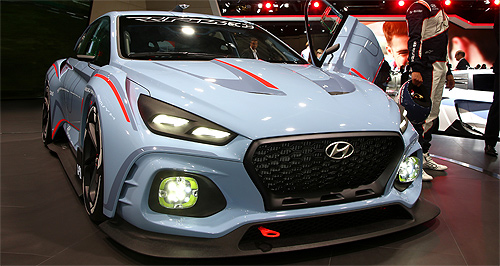Future models - Hyundai - RN30Paris show: Hyundai ‘closer’ to monster hatchCloser: Hyundai’s i30-based RN30 concept hides a powertrain and other technologies under development for future hot N cars from the South Korean manufacturer. Hyundai concedes it has potent technologies under development for hot i3030 Sep 2016 By RON HAMMERTON in PARIS HYUNDAI’S high-performance car development chief, Albert Biermann, has confirmed that his engineers are testing prototypes armed with the same potent 280kW turbocharged engine, eight-speed dual-clutch transmission and other advanced mechanicals as the RN30 concept car that is starring on the South Korean company’s Paris motor show stand. While the former vice-president of engineering at BMW’s M Automobiles says a Hyundai model carrying such racy gear is “not close to any mass production”, he conceded that Hyundai’s new N high-performance vehicle division was working on technologies for such beasts at its Namyang development centre in South Korea. “We have these prototypes on the test track, but there is no decision,” he said. “We are not even close yet to decide about it, but technically we are getting closer and closer.” The RN340 concept is dressed up as a racecar, but many of the features under the skin point to a high-end hot hatch in the Ford Focus RS mould. Speaking with Australian journalists at the Paris motor show where Hyundai in launching the third-generation i30, Mr Biermann divulged that Hyundai N had projects under development for Hyundai entities in Europe, South Korea and the United States, and had “started talking with China”. He confirmed that the i30N – an i30-based front-wheel-drive rival for hot hatches such as the Golf GTI, Renault Megane RS and Honda Civic Type R – was being readied for launch in the second half of next year and would be produced at Hyundai’s European plant in the Czech Republic for multiple markets including Australia. That car is expected to have about 192kW of power from its 2.0-litre turbo-petrol engine, driving the front wheels. But Mr Biermann said the opening N model would not be “on the utmost level of the high-performance segment”, instead residing in the “mid area of high performance”. Mr Biermann said Hyundai was not yet ready to go higher than that, preferring to take a careful, steady development path. In other words, Hyundai still has work to do to take the fight up to all-wheel-drive hatches like Mercedes-AMG’s 280kW A45, Audi’s 270kW RS3 and Ford’s 257kW Focus RS. “I think such a high-powered car is just too much to put out now,” he said. “I think first we need to grow some things with the i30N car, and we will have two levels – base and more track-oriented package car.” Mr Biermann hinted that other Hyundai models such as the i20 and Veloster might be expected to come under the N division’s spell. He said Hyundai had decided to start its N program with a C-segment small car – the i30 and perhaps Elantra – but would consider a B-segment project (i20). Mr Biermann hinted that the current Veloster would not be up to N development, but that the next generation – which GoAuto believes is coming in 2018 – would have “a lot of potential”. He even suggested he would like to generate an N version of the mid-sized Sonata, but that was not in the plan, and neither was any N-enhanced Hyundai SUV. Mr Biermann confirmed that Hyundai’s new luxury brand, Genesis, would not get any N variants, instead being kept totally separate from Hyundai. He said the eight-speed dual-clutch transmission being tested by N engineers would be applied to several Hyundai models, but added that it was too early to reveal them. “We have just finished developing a very nice eight-speed wet DCT for front-wheel-drive application,” he said. “That is not confirmed yet, but it is already in this car. I drove it already on the track.” Also under test is an electronically controlled limited-slip differential – an e-LSD – had also been developed in league with Hyundai’s in-house component supplier, WIA. He said this would split torque between the wheels without resorting to braking.  Read more29th of September 2016  Hyundai’s new-model blitzEleven new models set to reshape Hyundai in Australia in 18 monthsAll future models Alfa Romeo Alfa Romeo Abarth Abarth Audi Audi Aston Martin Aston Martin BMW BMW Bentley Bentley Chrysler Chrysler Chevrolet Chevrolet Dodge Dodge Citroen Citroen Ferrari Ferrari DS DS Ford Ford Fiat Fiat FPV FPV Foton Foton Haval Haval Great Wall Great Wall Honda Honda Holden Holden Hyundai Hyundai HSV HSV Isuzu Isuzu Infiniti Infiniti Jeep Jeep Jaguar Jaguar Lamborghini Lamborghini Kia Kia Lexus Lexus Land Rover Land Rover Mazda Mazda Maserati Maserati Mercedes-Benz Mercedes-Benz McLaren McLaren Mini Mini Nissan Nissan Mitsubishi Mitsubishi Peugeot Peugeot Opel Opel Proton Proton Porsche Porsche Renault Renault Ram Ram Saab Saab Rolls-Royce Rolls-Royce Smart Smart Skoda Skoda Subaru Subaru SsangYong SsangYong Tesla Tesla Suzuki Suzuki Toyota Toyota Volvo VolvoMotor industry news |
Click to shareHyundai modelsResearch Hyundai All future models Alfa Romeo Alfa Romeo Abarth Abarth Audi Audi Aston Martin Aston Martin BMW BMW Bentley Bentley Chrysler Chrysler Chevrolet Chevrolet Dodge Dodge Citroen Citroen Ferrari Ferrari DS DS Ford Ford Fiat Fiat FPV FPV Foton Foton Haval Haval Great Wall Great Wall Honda Honda Holden Holden Hyundai Hyundai HSV HSV Isuzu Isuzu Infiniti Infiniti Jeep Jeep Jaguar Jaguar Lamborghini Lamborghini Kia Kia Lexus Lexus Land Rover Land Rover Mazda Mazda Maserati Maserati Mercedes-Benz Mercedes-Benz McLaren McLaren Mini Mini Nissan Nissan Mitsubishi Mitsubishi Peugeot Peugeot Opel Opel Proton Proton Porsche Porsche Renault Renault Ram Ram Saab Saab Rolls-Royce Rolls-Royce Smart Smart Skoda Skoda Subaru Subaru SsangYong SsangYong Tesla Tesla Suzuki Suzuki Toyota Toyota Volvo VolvoMotor industry news |
































Facebook Twitter Instagram